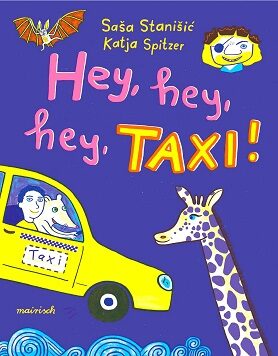Saša StanišićKatja Spitzer
Hey, hey, hey, Taxi!
[Hey, hey, hey, Taxi!]
- mairisch
- Hamburg 2021
- ISBN 978-3-948722-05-0
- 96 Pages
- 3 Suitable for age 4 and above
- Publisher’s contact details
Published in Italian with a grant from Litrix.de.
Sample translations
A colourful cascade of stories
Who would have thought that Saša Stanišić, winner of the 2019 German Book Prize, would come up with a collection of children’s stories? They owe their origin not only to bedtimes, but also to joint rambles and birthday gatherings. They have much to do with the function and delights of literature. Like all good stories they are intended to give pleasure, provoke benign puzzlement, and stimulate thought. To that end, Stanišić wholeheartedly approves when his stories prompt an interplay of questions and answers – and there is certainly no shortage of questions that the listener might wish to ask. Bursting forth as it were spontaneously, these tales are the product of an unbridled delight in storytelling, situated in locales such as a kindergarten for animals, in which a wise and wary fox shows his young charges the true nature of the world. But the taxi also whirls its passengers to the realms of dragons, giants and bats; it is a miraculous machine that can travel both forward into the future and back into the past. To seek to stir up our sense of the world through language, to imagine it as something quite different from what we normally perceive it to be – these are amongst the most fundamental aspirations of literature. And for Stanišić of course there is always plentiful scope for imaginative word-play.
More often than not the writers of literature for children and young adults are chiefly concerned with their chosen topics – but what interests Saša Stanišić is rather the ways that children experience fear, courage, injustice. This is also why the stories are left completely open. One minute the taxi might be boarding a pirate ship, the next it may be involved in an adventure with a robot. The child listening to any of these stories is free to extend the rumbustious plot-line and imagine an ending quite different from the one provided. The book is thus suitable not only for pre-schoolers but also for children who are already beginning to read for themselves.
In her illustrations Katja Spitzer displays the same sort of verve that animates Stanišić’s exuberant narrative. Scarcely ever earthbound, her figures mostly swoop to and fro above the page, their bodies lithe and supple as though ready to leap off at any moment in a new direction. Spitzer’s illustrations are two-dimensional in style, with everything happening in the foreground as in children’s drawings – which she mimics with great finesse, using a bold colour palette in which dark blue, turquoise, pink and yellow are directly juxtaposed.
Everything is possible in this book, which amasses creative ideas in great big heaps and then either arranges them like so many building bricks into neat stories, or else jumbles them up with cheerful abandon.
Translated by John Reddick

By Thomas Linden
Thomas Linden is a journalist (Kölnische Rundschau, WWW.CHOICES.DE) specializing in the areas of literature, theater and film. He also curates exhibitions on photography and picture book illustration.
Publisher's Summary
For a child, a taxi is a magic vehicle. A four-wheeled witches' broom. As you enter it, a taxi can bring you anywhere you want to.
But what if it's magic was even bigger? What if taxis would allure stories, fantastic and absurd stories, funny stories full of people and animals and giants and a pirate captain with four pirate captain hats? What if taxis were gateways for the fantasy of children?
This is exactly that kind of book: A book, in which a certain someone enters a taxi and with it a strange world, one of a kind. These journeys lead in all directions, to a place next door as well as through time and space. But in the end they always lead back home - back to the child.
Saša Stanišić wrote his first children's book – together with his son! Together they came up with the wildest, craziest, sparkliest adventures one can encounter in a taxi.
With a passion for detail, illustrator Katja Spitzer brought those ideas and it's creatures to life.
Big fun - and almost too exciting to be bedtime stories!
(Text: mairisch)
